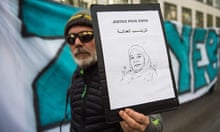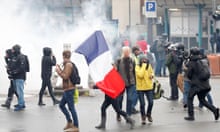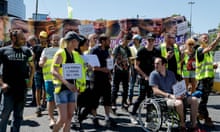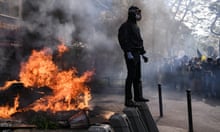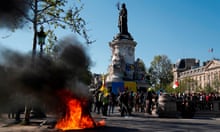French security forces contained fears of a fourth weekend of rioting by extremist gilets jaunes in Paris with a change of tactics including a massive show of strength.
About 8,000 police and gendarmes refused to allow the gilets jaunes to gain the upper hand, as they had the previous week, by attempting to filter out troublemakers before they could act. They put parts of the city into lockdown before dawn and carried out widespread stop-and-search operations. Plainclothes officers pinpointed extremist elements and made hundreds of “pre-emptive arrests”.
Small groups of gilets jaunes from the extremist fringe of the grassroots movement succeeded in playing cat-and-mouse with security forces, but were repeatedly pushed back by police using water cannon, mounted officers and armoured vehicles.
The government deployed a force of 89,000 police and gendarmes across France. Outside the capital, protests passed off mainly peacefully.
In a change of tactics from last week, when Paris saw the worst violence for more than 50 years, police and gendarmes chose to directly confront troublemaking demonstrators.
Stung by criticism that they lost control of the situation last week, politicians and police were reactive and mobile, determined not to let casseurs – vandals and hooligans – have their way again. Yesterday morning whole districts of the city were put into lockdown, with roads sealed off in an effort to contain protesters to the Champs-Élysées.
As the day wore on, however, groups of casseurs had police racing to deal with fires and barricades. Officers responded with water cannon and teargas.
Breakaway groups, young men dressed in black and wearing masks and scarves, dodged the security forces and teargas to build barricades and set fires around the city.
Police sources said they believed the “real” gilets jaunes had again been hijacked by extreme elements, including ultras from the left and right, and anarchist “black bloc” groups. In other parts of the country, the “real” gilets jaunes, as the French media now calls them, seemed determined to make their complaints peacefully.

The gilets jaunes began as a grassroots movement that grew out of widespread discontent with a new eco-tax on petrol and diesel, seen as hitting those living and working outside metropolitan areas where there is no public transport. In the past three weeks the movement has grown to include a range of diverse demands, including lower taxes, higher pensions and an improvement in ordinary French people’s spending power.
Last week President Emmanuel Macron announced that his government would drop the eco-tax, but protesters say the measure is too little, too late. The battle has pitched people in the countryside who feel they are ignored against a Parisian “elite” seen to have all the privileges.
The interior ministry claimed that there were 31,000 protesters across the country, police made more than 1,000 arrests and almost 500 people were held in custody; 55 people were injured, including three police officers.
The rioting spread to France’s neighbours yesterday where Belgian police fired tear gas and water cannons at gilets jaunes. Protesters in Brussels, calling for the resignation of prime minister Charles Michel, threw paving stones, road signs, fireworks, flares and other projectiles at police.
In the Dutch city of Rotterdam, a few hundred protesters wearing yellow vests walked downtown, singing and handing flowers to passers-by. Another 100 protesters held a peaceful demonstration outside the Dutch parliament at the Hague.
As night fell, and many “real” gilets jaunes made their way home, police were gearing up for violence, but considered the day a relative success.
For the authorities, the biggest difficulty has been distinguishing between the “real” gilets jaunes, intent on demonstrating peacefully, a thuggish element and the extremist political agitators, and knowing who to deal with when the organisation has no official leaders or organisation.
Marc, 31, a farmworker from Normandy, said he’d “had enough of paying high taxes”, yet he wasn’t planning to get into a fight with police. “There are troublemakers here, and I get the impression some of them may be anarchists or extremists or ultras, but I don’t know. We’re not,” he said.
“But there’s something not right here: if we demonstrate peacefully, the government ignores us. If some people burn cars and attack the police, the government gives in. What does that tell us?”
